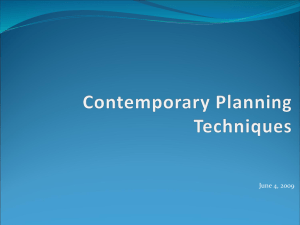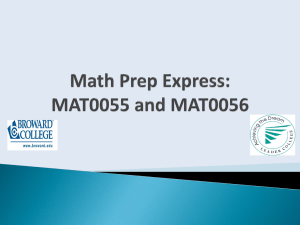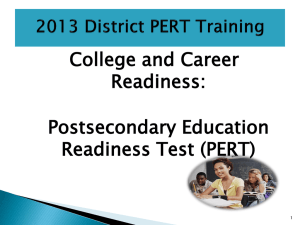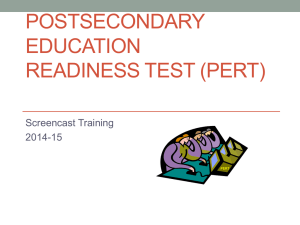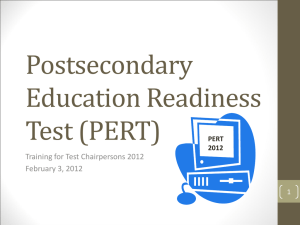9D - New Directions - the National College Testing Association
advertisement
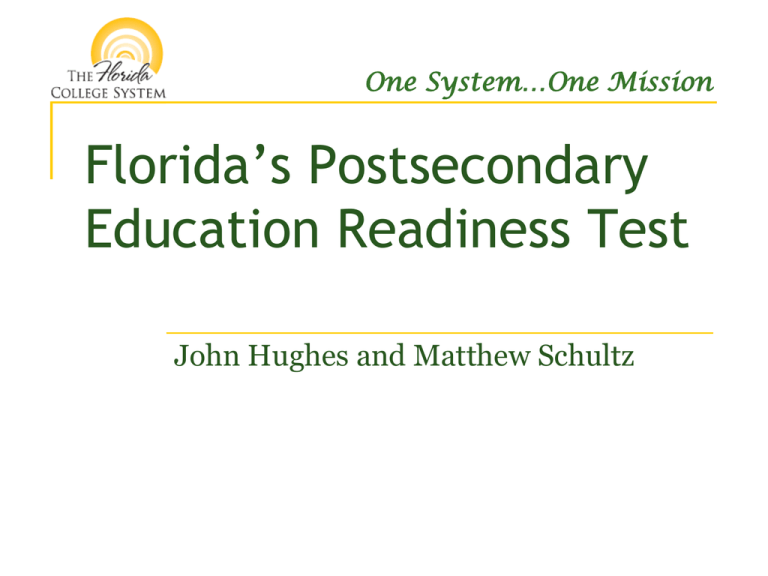
One System…One Mission Florida’s Postsecondary Education Readiness Test John Hughes and Matthew Schultz College Placement Testing in Florida Statutorily required placement testing Acceptable instruments defined in rule SAT, ACT, Accuplacer, and PERT Students who do not meet the scores placed in developmental education Required developmental education coursework must be completed before students may enroll in entry-level college credit courses 2 From Accuplacer to PERT American Diploma Project Readiness Competencies Contract Expiration Faculty Involvement McCann’s Customized Solution Florida’s postsecondary Education Readiness Test (PERT) Faculty Involvement Over 100 faculty from five school districts, two nonpublic colleges, nine universities and 24 colleges Identified Florida’s Postsecondary Readiness Competencies Prioritized the readiness competencies in terms of determining a student’s readiness for college-level coursework Helped develop the PERT blueprints based on the prioritized list of readiness competencies Reviewed test items to ensure they are aligned to the competencies and to ensure accuracy and clarity Took the test “as a student” to ensure the test is functioning as expected 4 Postsecondary Readiness Competencies PERT is aligned to Florida’s Postsecondary Readiness Competencies (PRCs) PRCs in reading, writing and mathematics Prioritized list of competencies for success in initial college credit courses True assessment of what students need to know before enrolling in introductory courses Follow up diagnostics that identify which competencies are not met for the purposes of remediation 5 Blueprint Development Series of meetings with stake holders from department and colleges PRC’s for each content area reviewed and prioritized by SME’s Critical PRC’s identified and weighted Blueprints developed to reflect most critical PRC’s for success Test Design Process PRC’s and Blueprints used to drive content development College Faculty developed content exemplars McCann developed item banks of content aligned specifically to PRC’s College Faculty reviewed all content and approved alignment DOE, Florida Colleges and McCann collaborated on pilot to test content Test Development Process Pilot included all colleges and most campuses 900+ items administered to samples of student test takers Online platform used to deliver content Psychometric review of item performance Item calibrations (3 parameter IRT) completed and CAT developed PERT launched operationally Fall 2010 Includes ongoing field testing of content Diagnostic Competencies Diagnostic exams are available for students not meeting the cut-scores Lower and upper level in reading, writing and mathematics Based on statewide common course descriptions Prioritized list of competencies for success in given course No passing/failing score, just results by competency 9 PERT Components PERT System Components Placement Tests (3 sub-tests) Identifies appropriate course placement (developmental education through college credit) Reading Writing Mathematics Diagnostic Tests Lower and upper level for each subject Based on separate competencies for exiting remedial courses 10 PERT Test Design 30 questions per placement subtest 25 operational items will be the basis of the student’s placement score 5 field test items to continually enhance the operational test bank Each test item is aligned with a PRC per the test blueprint All items have been approved and aligned by Florida faculty 11 PERT Test Formats PERT Placement is delivered using a CAT engine Draws on item banks of 200+ items per content area Item banks constantly being expanded PERT Diagnostics are linear Content delivered collaboratively between Florida College Faculty and McCann PERT Interim Cut Score Setting Data Pilot data Data reflecting current student enrollment – first course, first year of enrollment Data reflecting CPT/Accuplacer scores Target Establish PERT cut scores/ranges that result in course placement comparable to current enrollment numbers Two ranges for developmental education – lower and upper One score for entry level college credit Additional score for MAC 1105 College Algebra 16 Cut Scores and Expected Placement Math Placement Level 3-Year Average Percent of Students 0.5% 6.1% 13.9% 40.6% 38.9% Advanced Math College Algebra or Equiv Intermediate Algebra Upper Level Dev Ed Lower Level Dev Ed Cut Score Range NA 123-150 113-122 96-112 50-95 Expected Percent at Placement 7.1% 14.1% 41.9% 36.9% Reading Placement Level 3-Year Average Percent of Students Cut Score Range Expected Percent at Placement College Ready (ENC 1101) 40.5% 104-150 42.0% Upper Level Dev Ed 46.3% 84-103 45.1% Lower Level Dev Ed 13.2% 50-83 12.9% Writing Placement Level 3-Year Average Percent of Students 54.9% 20.4% 24.7% Cut Score Range 99-150 90-98 50-89 Expected Percent at Placement 55.3% 21.5% 23.2% College Ready (ENC 1101) Upper Level Dev Ed Lower Level Dev Ed Contact Information John Hughes Matthew Schultz Associate Vice Chancellor Director Psychometric Services Division of Florida Colleges McCann Associates Florida Department of Education mschultz@mccanntesting.com John.hughes@fldoe.org
